|
|
In the two previous parts I dealt with the Basketmaker stages, now I turn to the Pueblo Periods. Seeing the notion "pueblo", one asks oneself why scientists use Spanish names. The explanation is that the Spaniards were the first to see the buildings and towns of the Indians and, therefore, gave them the name "pueblo", which means town in Spanish. The Pueblo I period started at about 700 A. D. and lasted till about 900 A. D., bringing about many major changes for the Anasazi. In most areas at the beginning of the Pueblo Period, pithouses were still the common form of dwelling, their form, though, was not round or oval anymore, as in Basketmaker III times, but rectangular forms prevailed. These rectangular pithouses only existed for a short time between circular pithouses and surface structures. In comparison with its size, such a rectangular pithouse is quite shallow, from a foot to three deep and from ten to a maximum of fourteen feet long. The rectangular pithouse is sometimes referred to as a jacal structure - the name is applied to a construction in which walls were made by setting poles at short intervals. At first walls sloped inward, but later walls became more and more perpendicular, forming a structure with a rectangular roof. The Anasazi tried to reinforce the side walls with various materials such as rocks, clay, wattle-work and even adobe, thus developing true masonry, which itself made it possible for a house to emerge from the ground and be entirely built upon it. This new structure which is completely built above ground is referred to as surface structure or surface masonry structure. The surface dwellings were flat roofed and joined together in long rows, nearly all houses facing to the south or the southwest, sometimes a smaller room was behind such a structure for additional storage. Besides the fact that the pithouse emerged to above ground dwellings, another development of the pithouse structure began. Pithouses also began to assume the role of kivas, subterranean ceremonial chambers, which will certainly be established during the next, the Pueblo II, period.
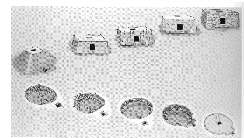
29 Pithouses evolved in two directions.
Some scientists believe that great kivas were already existing, resembling a church for a Christian, where not only ceremonial activities took place, but kivas were also a community centre. They were generally large, round, covered buildings that partially lay underground. Recently, the uncovered great kivas have been referred to as dance plazas, as scientists believe that dances took place on them.
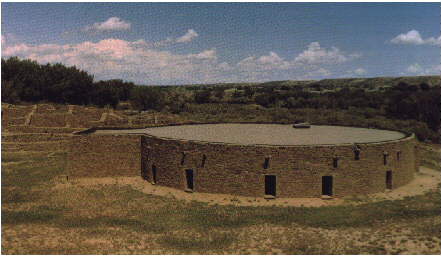
30 A great kiva.
Agriculture and hunting habits continued in a fashion similar to agriculture and hunting habits of the preceding period. New straits of corn, which were introduced from the Mexican area, had the ability to better withstand short growing seasons and arid conditions, which made it possible to enlarge the yields. Besides the new corn strait, another important crop, cotton, appeared during the Pueblo I period. It was also obtained from the Mexican area. With the local production of cotton we find the development of true textiles made on a loom. Kilts as well as breech clouts and blankets were now woven of the new material. Despite the introduction of cotton, yucca and apocynum were still used, especially in order to make sandals. Sandals of this period, as well as the ones of the following, the Pueblo II period, had rounded toes. Dogs and turkey were still the only domesticated animals, which probably were not kept for food - scientists found these animals buried with mortuary offerings. The hunting habits didn't change and the prevailing weapon was still the bow and arrow, but axes also appeared more often during this period. Baskets were still produced but the numbers of baskets made diminished and, as a consequence, the more durable and easy-to-make pottery vessels more and more began to replace baskets. Pottery during Pueblo I Period underwent some interesting changes. Vessels such as cooking vessels began to have a series of unsmoothened coils around the neck of the jars, giving them the name "neck-banded pottery".

31 These two vessels are examples of neck-banded pottery.
Vessels were still continued to be made and coloured in the same way, with the same simple patterns and the same black colour, giving them the name black-on-grey and black-on-white pottery. In some regions some black on red and some red-on-orange pottery appeared, this pottery, however, was produced in so small numbers that it cannot be considered a typical Pueblo I pottery. Towards the end of the period, designs slowly began to be no longer confined to the interior of bowls and ladles, but were placed all over a vessel. This development came to an end and had its highlight during the Pueblo II period. The principle elements which were painted onto the vessels were parallel lines, sometimes straight and in other cases stepped or wavy zig-zags, triangles, checkerboards and interlocking frets; both curvilinear and rectilinear designs were used (see appendix) . The most striking feature of the Pueblo I period is the advent of lambdoidal cranial deformation, or simply the deformation of skulls. While Basketmaker skulls were considered dolichocephalic, or long headed, Pueblo skulls were brachycephalic to mesocephalic, broad headed.
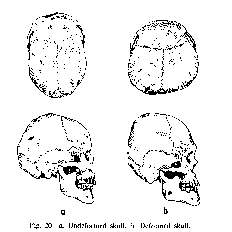
32 This overview shows the deformation of Anasazi skulls.
At first, scientists believed that Basketmaker People and Pueblo People were from entirely different origins, but later they found out that there was a simple cause for the change of the posterior of a puebloan skull, the cradle board. From various examinations and long and detailed studying archaeologists discovered that there are some differences between the two generations which are not of great significance, for, although changes occurred, there is a strong continuity of development from Basketmaker to Pueblo times. Scientists today believe that the skull deformation is simply the result of strapping babies against a now hard cradle board, instead of the soft cradle board of former times. The soft skull of an infant was flattened by the pressure and as the bones grew and hardened, the skull deformation was permanent. Why the Anasazi started wanting to have deformed skulls is still a riddle, some scientists though believe that it was a "matter of fashion" .
[...] We cannot be sure of the answer, of course, but it seems possible that it represents nothing more than a matter of fashion and a change in the ideal of beauty.[...] 33
During the Pueblo II times, villages were generally built in the open on the mesa tops and were surrounded by farmland. Again the major changes occurred in architecture. Another type of village orientation which had its roots in the Pueblo I period, continued and developed during Pueblo II times. This sort of dwelling is the unit house. Unit houses are above ground structures built of stone and adobe, usually one story in height containing from 6 to 14 rooms. These rooms were either placed in an long row, sometimes in a double tier, or were arranged in the shape of an "L" or a rectangular "U". Unit houses are also sometimes referred to as clan houses - the term clan house was given to them, because scientists believe that they may have been occupied by single family groups. Several related families constituted a clan which, according to archaeologists, was matrilineal (descent through the female line) in organisation. Certainly, it was also in this period that the kiva was established. Kivas are circular subterranean houses which evolved from the pithouses. Kivas were always partly underground, even if the soil would not permit digging a hole. In that case the Anasazi would pile up soil all around the kiva thus pretending that the kiva were underground. Kivas are rather small with a diameter of about twelve to fifteen feet. The wall is lined with a bench or banquette whereon there rest six or eight stone pilasters with the function of supporting the roof. The roof was formed by placing poles across the pilasters and finally additional poles were placed across the angles, forming a dome shaped roof. Again, the most significant features of a kiva lie in the interior. In comparison with the pithouse, a kiva also contains a ventilator shaft, permitting outside air to enter, a deflector, keeping drafts from blowing out the fire, a fire pit and the so-called sipapu, the entrance to the underground. A kiva was entered through a hole in the roof, which was located above the fire pit, whereas various authors such as Wormington report
"tunnels connecting kivas to other structures such as stone towers ". 35
Warm in winter and cool in summer, kivas were used for weaving, toolmaking, education, storytelling, and family gathering.
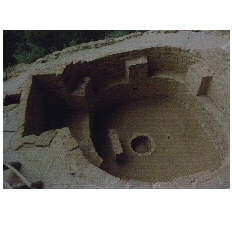
34 Interior of a kiva.
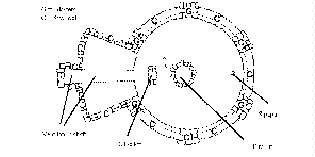
36 A floor plan of a "keyhole" kiva.
While talking about architecture you always have to think of the regional differences. In some sections, for example, the Anasazi already built big pueblos while in others progress and advancement had not reached them yet and pithouses were still the predominant structures. In the Chaco Canyon area of New Mexico, however, progress had been quite advanced. This is why one can find,
"the most impressive site in the entire Southwest to that time"38
, as John C. McGregor says , Pueblo Bonito. While the Puebloans in the other regions of the Southwest had just started building unit houses, a new type of house, the great house, communal house or public building started to be constructed in the Chaco Canyon area. The best know "great house" is Pueblo Bonito. It is not only the largest masonry structure made in this time, but it was also obviously planned and executed as a definite unit. Building at Pueblo Bonito had begun as early as 919 A. D., but it had not reached its final form until 1067 A. D. Pueblo Bonito was a town consisting of only one house, covering over three acres of ground with its more than 800 rooms and 30 kivas. The main building was terraced back from one storey level in the front to four storeys in the rear.
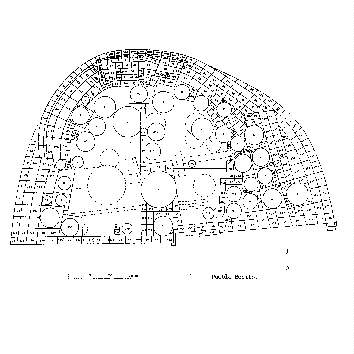
39 Plan Of Pueblo Bonito.
Its height was increased by one storey for each succeeding row of rooms. A one storey row of rooms extended from the ends and enclosed the sides to the south. Outside this row was the rubbish heap, around which retaining walls were built. Either within the centre court or incorporated in the building mass, the Puebloans built their kivas. In addition to the "small" kiva in Pueblo Bonito, one can also find the Great kivas which served an entire community whereas the "small" kiva served only one clan or family. At first, the Pueblo had big windows and doorways in the outer wall but these were later blocked off with masonry, probably because the Puebloans were threatened by some sort of danger, perhaps an attack by barbarians. Another piece of evidence for a certain fear is that the entrance gateway was also completely closed. Access was now only possible by using a ladder, which in case of an enemy attack could be withdrawn making it nearly impossible for an enemy to enter the Pueblo. Another interesting phenomenon about the Chaco Canyon area is that there the first "roads" appeared, connecting all the smaller villages, called "outliers" with the main village, Pueblo Bonito. These roads radiated out from Pueblo Bonito of which scientist believe that it was more a storage, ritual and administrative centre than a residential centre.
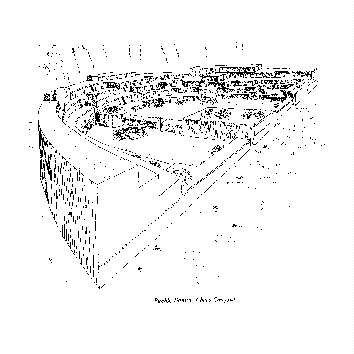
40 This illustration shows what Pueblo Bonito probably looked like.
Villages during the Pueblo II time were generally built in the open on the mesa tops and were usually surrounded by farmland. Because of the open nature and the fact that good footing was not too important only few sandals have been found. The sandals which have been found are from the rounded toe or the notched toe type which will be described later as they are more characteristic of the Pueblo III period. Again, only little information concerning clothing has been found - most of the perishable material withered away - fragments, though, dated this age, indicate that quite long fabrics were woven requiring the invention of a true vertical loom. Basketry was still in use as coiled baskets and twilled baskets, but the number of woven baskets decreased while the dependence on pottery increased because vessels made of pottery became better and better. Hunting implements as well as agricultural implements did not really change, except the arrow, which is of particular interest as it is now not anymore made of a single part, but made of two parts in the same way as the atlatl dart was made centuries before. The main part of the shaft was made of a light reed. To the one end, three feathers were attached to aid directing the arrow while flying. The pointed hardwood foreshaft was fitted into the other end which was left hollow. Finally, a stone point was attached to the end of the foreshaft.

41 This illustration shows a bow and an arrow.
The best characteristic of the pottery of the Pueblo II period is the corrugation. As a result of development from the neck-banded pottery of the preceding period, where only the neck was corrugated, pottery was now corrugated all over. This corrugation sometimes even formed a geometric pattern. Some scientist are of the opinion that the Anasazi did not just corrugate their ware for decoration, but also did it for a utilitarian purpose by increasing the surface of the outside in relationship to the surface of the inside of the vessel and so gathering heat over a larger area, so facilitating higher temperatures in less time. Other writers such as McGregor postulate that
"this would credit the makers (Anasazi) with more reasoning intelligence than they probably possessed in such a matter".42
Apart from the corrugated pottery black on red pottery started to appear in sufficient abundance.
This Period is marked by a big population movement and a crowding together of people. Fewer but larger Pueblos were occupied and built. The Anasazi did not anymore expand over a big territory, but settled more densely in various regions. In many areas, the Anasazi moved from open locations to shelters and ledges in canyon walls. A precise reason for this movement cannot be given, one of the most common theories, however, is that the Anasazi were afraid of being attacked and, consequently, moved into the shelters of the canyons. Evidence for this theory are peepholes which were added to structures, large towers, which perhaps had the function of watchtowers, and walls which were built around such a village limiting the access. W.M. Ferguson said that
"the pueblos were like smaller versions of medieval castles of Europe"43.
Along with this theory, many other theories exist, one of them is that climatic changes made the Puebloans move to the shelters of the rocks, because many of them are situated at a lower altitude with perhaps better climatic conditions. These are all theories nobody will ever find evidence for, as long as we will not be able to travel in time. Nevertheless, although we do not know why such a movement took place, the Pueblo III period is the best known culture period of the Anasazi which is also known as the "Great Pueblo Period" as well as the "Classic Period". Due to the movement into the shelter of the caves, the Anasazi got their byname "cliff dwellers". They built numerous villages in canyon ledges, sometimes even some with five and more stories in height. Masonry in some regions became excellent as the builders now shaped the sandstone into blocks. In many areas large towers were erected by true masonry. These towers are often attached to kivas and may have had ceremonial functions in addition to the postulated defensive ones. The Pueblo III people built enormous community houses with a great number of rooms. Sometimes the Anasazi seem to have built for the fun of building and not because they needed living space, for there are rooms in apartment houses which show no trace of having been occupied. Rooms were built adjoining one another and above one another. Rooms in such houses were entered either by a door in the wall or in the roof, or by a hatchway. These houses did not anymore solely have a door, but they also had windows. Doors and windows were, especially in bad weather conditions, frequently covered either by a sandstone slab or by fur. Some of these enormous structures had walls which were as much as five feet thick and plastered with adobe on the inside as well as on the outside. The roof of such a house was still made by laying beams from wall to wall, sometimes branches were laid above the heavy beams in a checkerboard pattern before the brush and the mud were put on in order to finish the roof. The most impressive and best known dwellings of this time are undoubtedly the cliff dwellings of the Mesa Verde, above all Cliff Palace. Cliff Palace is nestled in a huge alcove, which is 89 feet deep, 59 feet high and 324 feet high, and contains about 220 rooms, 23 kivas and many stone towers, giving home for at least 250 people.
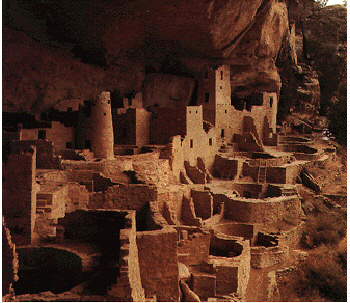
44 This photograph shows Cliff Palace.
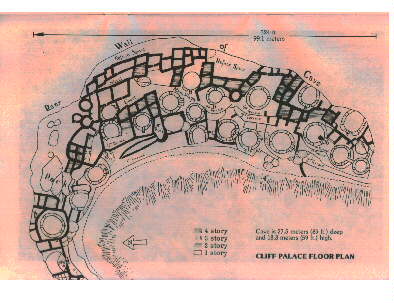
45 Plan of Cliff Palace.
The name "Palace" is quite misleading as Cliff Palace was no palace where a king or queen or any other sovereign reigned, but was a structure probably built for the peasants. Cliff Palace is a terraced building in some places reaching to four stories in height, limited through the height of the alcove. Rooms in Cliff Palace are relatively small, irregular in shape and have low ceilings. Fourteen storage rooms were found in Cliff Palace, which measured only about three feet in height, indicating that storage was of great importance. Other rooms are believed to have been milling rooms as many manos and metates as well as rests of corn have been found in them. Some rooms were entered through the roof, others, though, had doors, some of which were even T-shaped. Nevertheless, people did not spend too much time in their rooms, which were generally quite small, making living for normal sized people quite uncomfortable. Life took place on the terraced roofs of buildings and on the open courts as well as in the kivas, where mostly men met. In addition to these structures, stone towers occur in a great abundance. The stone towers of the Mesa Verde, or better in Cliff Palace, had diverse shapes, including round, oval, D-shaped and rectangular forms. The function of these towers is unknown. They may have served as watchtowers or as fortresses, some of them stand in a very good position to observe the surrounding land, others, however, do not, or they may also have served as solar observatories to obtain astronomical data, which are of great importance for the planting and harvesting of crops and the fixing of dates for religious ceremonies connected with planting and harvesting. Cliff Palace has kivas set into the courtyard at the front of the Pueblo, all more or less of the type described in the previous chapter. One fascinating thing about kivas in Cliff Palace is that two of them are joined by a tunnel. Other kivas are joined to a room. Scientists believe that these tunnels were designed to allow the priests to make use of a dramatic appearance or disappearance during kiva ceremonies. This would give the impression that priests were either rising from the earth or vanishing into the earth.
Perhaps they were used theatrically for sudden appearances or disappearances during ceremonies. Modern Pueblo people initiate children into the kiva societies and sometimes use theatrical devices as part of the initiation rite. You can imagine the effect such devices would have on 8 or 9 year old children. 46
Architecture in Cliff Palace is of great importance and brilliance. Rooms were also painted. Elaborate wall paintings can be found in some rooms of Cliff Palace. Paintings which are in an especially good condition can be found in a four story dwelling. Wall paintings here are made of red ochre and hematite paint. Water supply was a constant problem in the entire Southwest from which the inhabitants of Cliff Palace could not escape either. In order to get fresh water they had to walk at least 300 metres through very rough territory. They had to go down to the canyon floor. They accessed the canyon floor and the mesa above by a sort of ladder or staircase. They cut hand and toe holds into the cliff face allowing to go up and down.
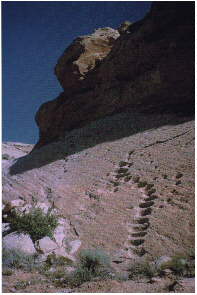
47 Hand- and toeholds
Sometimes the Anasazi "hammered" holes into the surface of big stones, which would, in case of heavy rain, be filled with water, saving the hard work of climbing up and down the cliff wall. Besides Cliff Palace, many other cliff dwellings such as Balcony House and Spruce Tree House can be found in Mesa Verde National Park, but cliff dwellings do not only occur in Mesa Verde, but can be found all over the entire Southwest. Agriculture and hunting habits did not really change from Pueblo II to Pueblo III times. Naturally the Anasazi tried to enlarge their yields and therefore tried to improve their irrigation systems they had already practised several hundred of years. With these irrigation systems the Puebloans, for example, made use of water reservoirs or check dam farming as well as floodwater farming. Baskets were still produced in Pueblo III times, in fact, basketry never really disappeared. Sandals again appear in great abundance. The notched toe type, which is now made of the twilled technique and not anymore with the help of the twined technique which was the most characteristic technique of Basketmaker times up to Pueblo III times, is the most characteristic sandal of this period. The notch for the toe of such a sandal is made in the area of the small toe, indicating that now to the first time definite rights and lefts were made.
Again the most striking fabrics were cotton cloths which were of amazing size. Pottery during Pueblo III times is marked by the appearance of polychrome pottery, pottery which is not only decorated by a single colour but as the name indicates by many ( Greek = poly; English = many) colours. An example of polychrome pottery is the so-called Kayenta pottery. The basic colour of this type was yellow to orange, designs were applied in black, red and white paint. Besides the polychrome pottery, black-on-white pottery, from Mesa Verde for example, and the corrugated pottery reached a high level. Designs of this period are of great diversity, decorated either by geometric patterns or by life forms. Band patterns were extremely common as well as large solid elements and hatchered patterns. Pueblo people of this Period did not change physically. They still have the posterior deformed skull, which makes the head look round and broad, caused by the hard cradle board. The great Pueblo Period ended with the abandonment of the San Juan drainage and with a population movement, now not from the mesa tops into the cliffs, but from the very arid countryside into a countryside with more rainfall.
Having now determined the three earliest Pueblo Periods I now want to turn to the Pueblo IV period or according to the Robert's Classification, the "Regressive Pueblo Period". As the terminology in the Robert's Classification indicates, during this period the Anasazi found themselves in a regression. Under the Pecos classification this stage was defined as
"the stage characterised by contraction of areas occupied; by the gradual disappearance of corrugated wares; and in general by decline from the preceding cultural peak." 49
The Pueblo IV Period is a period marked by great instability. During this stage, migration occurred which caused the shift of population centres. The Anasazi now moved into the same regions their successors still live in, the little Colorado River area to the south, which is the home for the Hopi and Zuni Indians, and the Rio Grande area to the east.
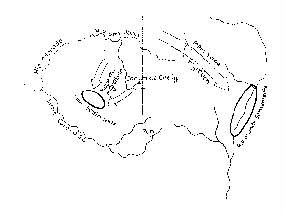
50 Map showing that the Anasazi abandoned their Cliff dwellings and fled to the South and the East
Naturally the question arises why the Anasazi people so suddenly began to abandon the cliff dwellings they built during the former period in such an ingenious way. For this question again no concrete answer can be given, but again many theories concerning this matter exist among the scientists. The main contributing factor to the abandonment of the former Anasazi settlements probably was a great drought. Tree ring workers recognised that very narrow rings occurred during the late 1200s. These rings are a signal that only very little water was available for a tree and, consequently, only little water was available for men as well. This drought lasted about twelve years, starting in the 1270s and ending in the 1280s. Beside this theory scientists take another interesting theory into consideration, too. This theory is based on the appearance of fierce and hostile nomadic tribes which probably were the ancestors of the Navahos and Apache Indians. Scientists hold the opinion that these nomadic tribes drove the Pueblo IV people from their homes. From my reading knowledge, I cannot give a precise reason for the abandonment of the original Anasazi region. The trend in architecture during Regressive Pueblo times was towards larger houses. In the Hopi region, for example, the early houses already covered about an acre of ground, while the later houses became much bigger, now covering from ten to twelve acres of ground. Such houses were made up of long rows of buildings with plazas between them, forming a village. Kivas built at that time were now rectangular in form and had an average length of about fourteen feet and a width of about eleven feet.
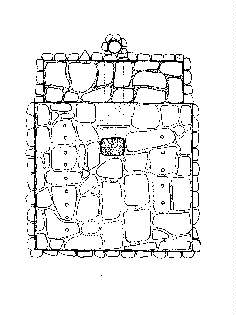
51 This is the floor plan of a kiva in the Hopi region.
A short banquette or bench is set off in a niche about three feet deep at one end or side of the room. The Pueblo IV kivas still have the characteristic features of a kiva. They contain a ventilator, a deflector, a firepit and a sipapu. A new interesting fact is the presence of one or more rectangular sandstone loom blocks. They were found on the usually stone paved floor. They are sandstone blocks with depressions designed to hold poles on which the worn threads are wound. The finding of such loom blocks is quite interesting because today the weaving is still done by men in kivas. In the Zuni district, houses were much the same as those of the Hopi country. Kivas in the Zuni district, however, are different from those of the Hopi district. They look more like the Chaco Canyon and Mesa Verde kivas. I visited some of the ten contemporary Hopi mesa-top pueblos in Arizona such as Walpi and Old Oraibi the latter being one of the oldest continuously inhabited settlements in the United States, dating back to 1150. I discovered that they as well as the modern Hopi villages in the valleys contained the only houses built of true masonry, whereas most of the other American houses are wooden constructions. The nineteen pueblos in New Mexico, among them Zuni Pueblo, Acoma Pueblo and Taos Pueblo, are also built of stone.
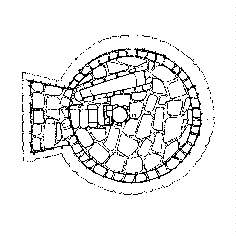
52 This is a floor plan of a kiva in the Zuni area.
In the interior, though, these kivas do not differ from the kivas in the other regions. They, too, show the known characteristics, such as a fire pit, a ventilation system, a deflector, a sipapu, etc. . The third region the Anasazi migrated to is the Rio Grande region. In this region, according to Wormington,
"people with an earlier Pueblo Culture were just beginning to come together into large communities when this period ( the Pueblo IV) began."53
This trend of crowding together in big houses was intensified by the migration of Anasazi people and, as a consequence of this, houses became larger in size and fewer in number. The main substance the houses were built of, again, were tuff blocks and adobe. Besides the already known Pueblo houses, the Pueblo IV people started building so-called cavate dwellings, rooms which are excavated into the back walls of caves and have porch-like chambers in front. The biggest and strongest Pueblo during Pueblo IV Period was the Pueblo at Pecos. The Pecos Pueblo lay at the Pecos River in what today is northern New Mexico. Work here started at about 1300 A. D., the final abandonment of this village though was not until 1838. As such a long record exists it is only natural that very many extensive and painstaking archaeological excavations were undertaken here at Pecos, thus making Pecos a centre of exchange of views finally leading to the fact that the name of the village of Pecos was used for the classification system obligatory or binding for scientists dealing with the history of the "ancient ones". All in all, the culture of this period in comparison to the one of the preceding period did not change very much, but is very similar to it. One of the most characteristic features I already mentioned above is the presence of loom blocks, used to set up a loom in the right position, which could be found in almost every kiva.
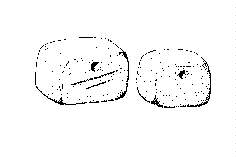
54 This illustration shows two loom blocks.
I hardly found any information concerning fabrics and even less concerning sandals, the yucca ring basket and the coiled basket, though, still seem to have been made. Sandal types, too, were probably made with the same technique as in the former period. Pottery during the Pueblo IV Period is marked by the introduction of glazed pottery. The term glazed perhaps is misleading as it is no real glaze but a sort of pseudo-glaze made of galena. This new type of pottery only appears in the Rio Grande area, in the other areas polychrome wares were still the most common. The Pueblo IV Period finally ends with the arrival of the Spaniards at about 1600 to 1700 A. D. This is also a fascinating or perhaps an amusing point as the Americans do not drop the term "prehistoric" until 1700 A. D., whereas in Germany and everywhere else in Europe the term "prehistoric" is dropped with the first appearance of handwriting at about 8000 B. C. That is also the reason why only the Period from about 1700 A. D. is referred to as the "Historic Pueblo Period".
The Pueblo V Period started with the appearance of the Spaniards. Discussing this Period, however, would be a topic of its own and, in my opinion, is not a specific problem of this essay. Nevertheless, I think some comments should be made on this final period. Generally, one can say that, on the one hand, this period was marked by warfare of the Spaniards against the Anasazi and, on the other hand, the Navaho raiders again against the Anasazi Indians. The only areas occupied at this time were the plateaus of the Hopi and Zuni sections. Sites in these areas grew larger and larger and finally most of them were moved to the tops of the mesas as a means of defence. Architecture generally remained the same, kivas and houses were still built in the same known way. Naturally, the arrival of the Spaniards also brought some changes. Due to the Spanish influence, staircases, ovens and chimneys were introduced and became abundant. The general plan of the Pueblo house, though, remained nearly unchanged. Polychrome pottery was still the predominant form of pottery, but, in the same way as architecture was influenced, influences of Spanish and European traditions started to reform Indian pottery vessels. Apparently these European-style formed vessels never became popular except for water bottles and canteens. Finally, since 1900, many alterations were affected. Certain groups split from older conservative elements and established more European-style villages. The Spaniards as well as the Navahos also brought along the features of metalworking, allowing the Anasazi to make rings, bracelets, earrings and similar ornaments. All in all, as a summary of this period, one can say that it was marked by warfare of either the Spaniards or the Navaho against the Anasazi People. Nevertheless, the Hopis are still found in the region where they lived already 100 years before, houses, objects and habits have only changed little during the years.

55 Aerial view of a Hopi village.
Top
|
|

















